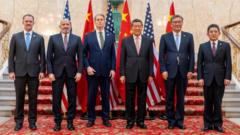In a significant step towards easing trade tensions between the world's two largest economies, US Commerce Secretary Howard Lutnick announced that a framework has been reached that aims to address restrictions on vital resources like rare earth minerals and magnets. This development comes after intensive negotiations lasting two days, during which both parties agreed to present the plan to their respective leaders, President Donald Trump and President Xi Jinping, for their endorsement.
This agreement follows a period of heightened friction, marked by accusations from both sides regarding breaches of previous trade deals. The urgency for resolution stems from last month, when the US and China opted for a temporary truce surrounding trade tariffs, which has seemingly faltered since, with both nations claiming non-compliance.
Lutnick emphasized the significance of this framework, which intends to uphold the "Geneva consensus" reached during a recent phone discussion between Trump and Xi. Chinese officials echoed this sentiment, indicating progress based on the understandings shared in their top-level talks.
For context, the trade war escalated dramatically after Trump imposed hefty tariffs on imports, significantly affecting Chinese goods while provoking retaliatory measures from Beijing. By May, a temporary truce reduced tariffs, but both parties have alleged subsequent violations of the agreement's non-tariff stipulations.
As discussions evolve, the Chinese Ministry of Commerce recently greenlit certain applications for rare earth export licenses, signifying a potential thaw in restrictions. Meanwhile, Trump claimed that Xi is on board with resuming trade in these essential materials, a crucial element in various advanced technologies.
With the next steps now lying in the hands of both nations' presidents, the focus will shift to their commitment towards finalizing this ambitious trade framework that holds substantial implications for global commerce.
US-China Trade talks wrap up with new agreement awaiting presidential endorsement.
This agreement follows a period of heightened friction, marked by accusations from both sides regarding breaches of previous trade deals. The urgency for resolution stems from last month, when the US and China opted for a temporary truce surrounding trade tariffs, which has seemingly faltered since, with both nations claiming non-compliance.
Lutnick emphasized the significance of this framework, which intends to uphold the "Geneva consensus" reached during a recent phone discussion between Trump and Xi. Chinese officials echoed this sentiment, indicating progress based on the understandings shared in their top-level talks.
For context, the trade war escalated dramatically after Trump imposed hefty tariffs on imports, significantly affecting Chinese goods while provoking retaliatory measures from Beijing. By May, a temporary truce reduced tariffs, but both parties have alleged subsequent violations of the agreement's non-tariff stipulations.
As discussions evolve, the Chinese Ministry of Commerce recently greenlit certain applications for rare earth export licenses, signifying a potential thaw in restrictions. Meanwhile, Trump claimed that Xi is on board with resuming trade in these essential materials, a crucial element in various advanced technologies.
With the next steps now lying in the hands of both nations' presidents, the focus will shift to their commitment towards finalizing this ambitious trade framework that holds substantial implications for global commerce.
US-China Trade talks wrap up with new agreement awaiting presidential endorsement.




















